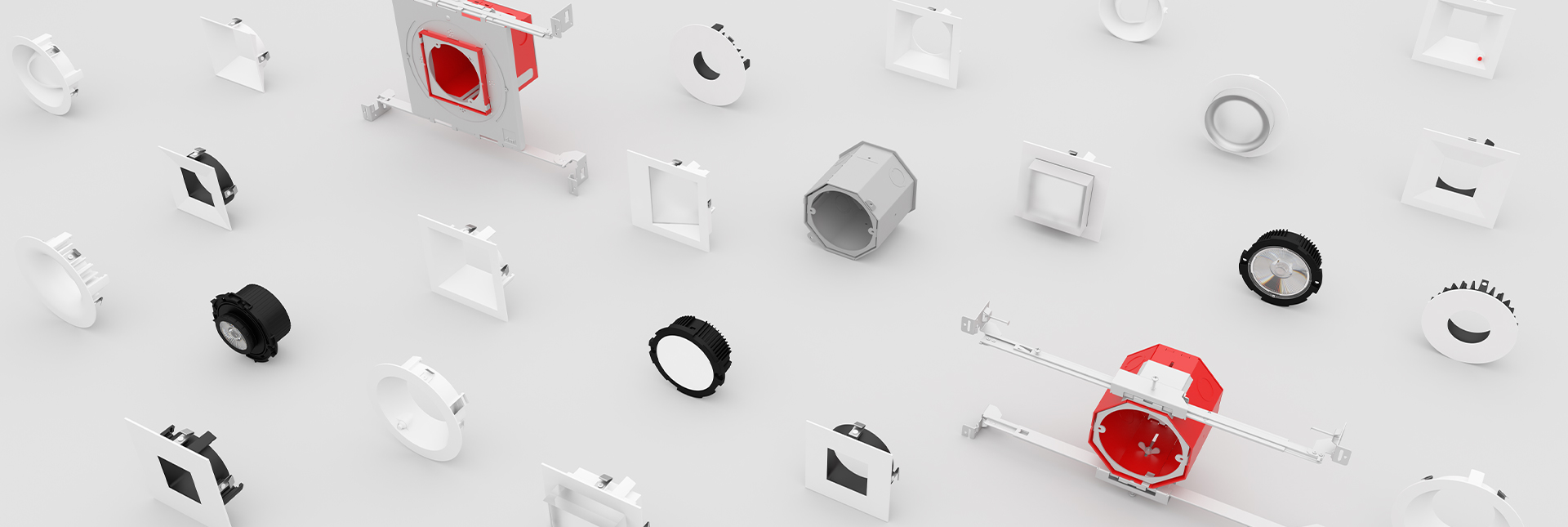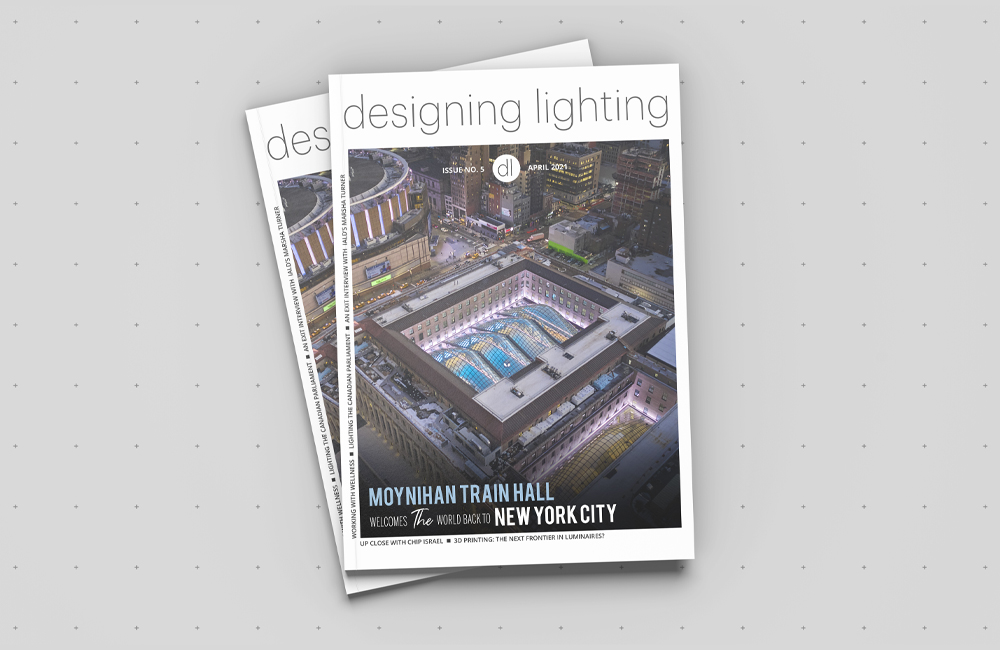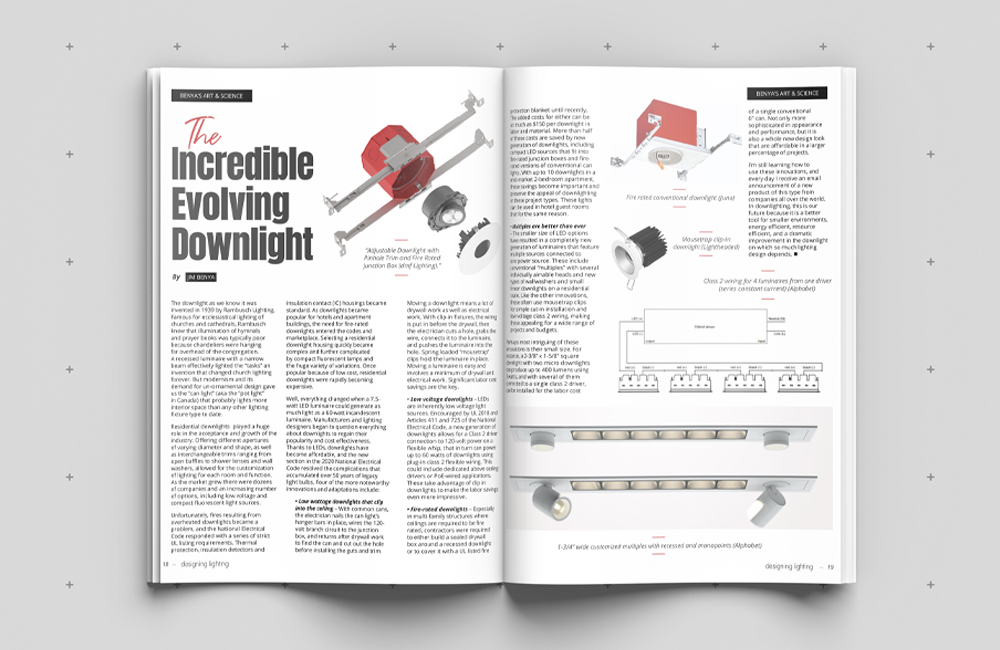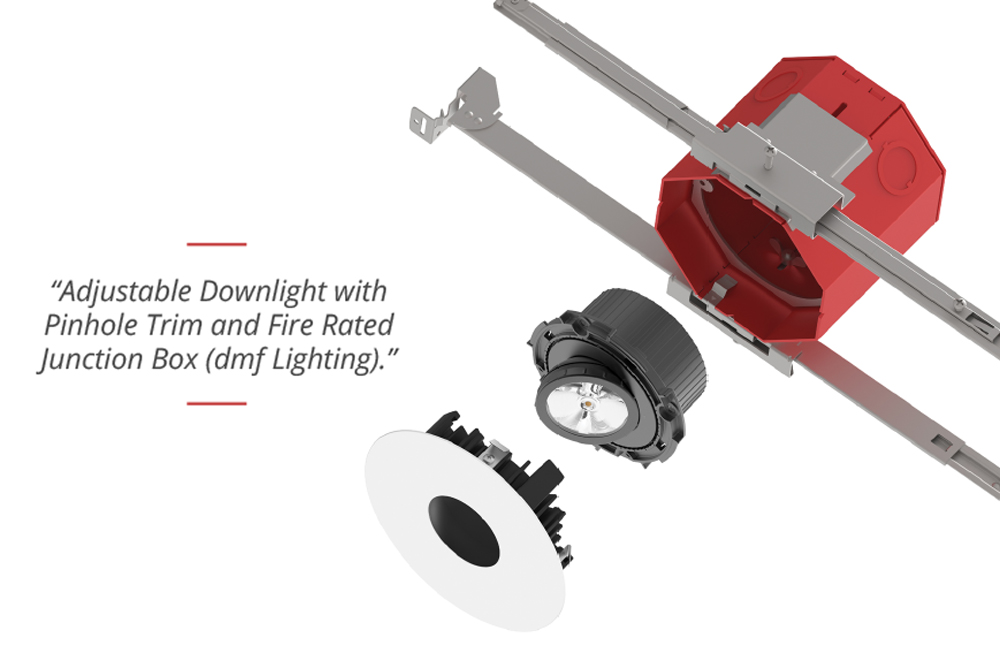
designing lighting is focused on the Business of Lighting Design™ and provides business information to the lighting design community. In addition to the website, designing lighting publishes bi-monthly online magazines featuring original content, interviews within the community and highlights successful and award-winning lighting designs.
In the April 2021 issue, Benya’s Art & Science section featured a fascinating article on the history of the downlight, covering everything from their origin to their latest features.


The Incredible Evolving Downlight
By Jim Benya
The downlight as we know it was invented in 1939 by Rambusch Lighting. Famous for ecclesiastical lighting of churches and cathedrals, Rambusch knew that illumination of hymnals and prayer books was typically poor because chandeliers were hanging far overhead of the congregation. A recessed luminaire with a narrow beam effectively lighted the “tasks” an invention that changed church lighting forever. But modernism and its demand for un-ornamental design gave us the “can light” (aka the “pot light” in Canada) that probably lights more interior space than any other lighting fixture type to date.
Residential downlights played a huge role in the acceptance and growth of the industry. Offering different apertures of varying diameter and shape, as well as interchangeable trims ranging from open baffles to shower lenses and wall washers, allowed for the customization of lighting for each room and function. As the market grew there were dozens of companies and an increasing number of options, including low voltage and compact fluorescent light sources.
Unfortunately, fires resulting from overheated downlights became a problem, and the National Electrical Code responded with a series of strict UL listing requirements. Thermal protection, insulation detectors and insulation contact (IC) housings became standard. As downlights became popular for hotels and apartment buildings, the need for fire-rated downlights entered the codes and marketplace. Selecting a residential downlight housing quickly became complex and further complicated by compact fluorescent lamps and the huge variety of variations. Once popular because of low cost, residential downlights were rapidly becoming expensive.
Well, everything changed when a 7.5-watt LED luminaire could generate as much light as a 60-watt incandescent luminaire. Manufacturers and lighting designers began to question everything about downlights to regain their popularity and cost effectiveness. Thanks to LEDs, downlights have become affordable, and the new section in the 2020 National Electrical Code resolved the complications that accumulated over 50 years of legacy light bulbs. Four of the more noteworthy innovations and adaptations include:
Low wattage downlights that clip into the ceiling – With common cans, the electrician nails the can light’s hanger bars in place, wires the 120-volt branch circuit to the junction box, and returns after the drywall work to find the can and cut out the hole before installing the guts and trim. Moving a downlight means a lot of drywall work as well as electrical work. With clip-in fixtures, the wiring is put in before the drywall, then the electrician cuts a hole, grabs the wire, connects it to the luminaire, and pushes the luminaire into the hole. Spring loaded “mousetrap” clips hold the luminaire in place. Moving a luminaire is easy and involves a minimum of drywall and electrical work. Significant labor cost savings are the key.
Low voltage downlights – LEDs are inherently low voltage light sources. Encouraged by UL 2018 and Articles 411 and 725 of the National Electrical Code, a new generation of downlights allows for a Class 2 driver connection to 120-volt power on a flexible whip, that in turn can power up to 60 watts of downlights using plug-in class 2 flexible wiring. This could include dedicated above ceiling drivers or PoE-wired applications. These take advantage of clip in downlights to make the labor savings even more impressive.

Fire-rated downlights – Especially in multi-family structures where ceilings are required to be fire rated, contractors were required to either build a sealed drywall box around a recessed downlight or to cover it with a UL listed fire protection blanket until recently. The added costs for either can be as much as $150 per downlight in labor and material. More than half of these costs are saved by new generation of downlights, including compact LED sources that fit into fire-rated junction boxes and fire-rated versions of conventional can lights. With up to 10 downlights in a mid-market 2-bedroom apartment, these savings become important and preserve the appeal of downlighting in these project types. These lights can be used in hotel guest rooms for that same reason.
More than half of these costs are saved by a new generation of downlights, including compact LED sources that fit into fire-rated junction boxes
Multiples are better than ever – The smaller size of LED options have resulted in a completely new generation of luminaires that feature multiple sources connected to one power source. These include conventional “multiples” with several individually aimable heads and new types of wall washers and small linear downlights on a residential scale. Like the other innovations, these often use mousetrap clips for simple cut-in installation and low voltage class 2 wiring, making these appealing for a wide range of projects and budgets.
Perhaps most intriguing of these innovations is their small size. For instance, a 2-3/8” x 1-5/8” square downlight with two micro downlights can produce up to 400 lumens using 5 watts, and with several of them connected to a single class 2 driver, can be installed for the labor cost of a single conventional 6” can. Not only more sophisticated in appearance and performance, but it is also a whole new design look that is affordable in a larger percentage of projects.
I’m still learning how to use these innovations, and every day I receive an email announcement of a new product of this type from companies all over the world. In downlighting, this is our future because it is a better tool for smaller environments, energy efficient, resource efficient, and a dramatic improvement in the downlight on which so much lighting design depends.
View the entire article at designing lighting.
————————–
Connect on LinkedIn, Instagram, Facebook, or Twitter to stay up to date with everything that’s happening at DMF Lighting.
